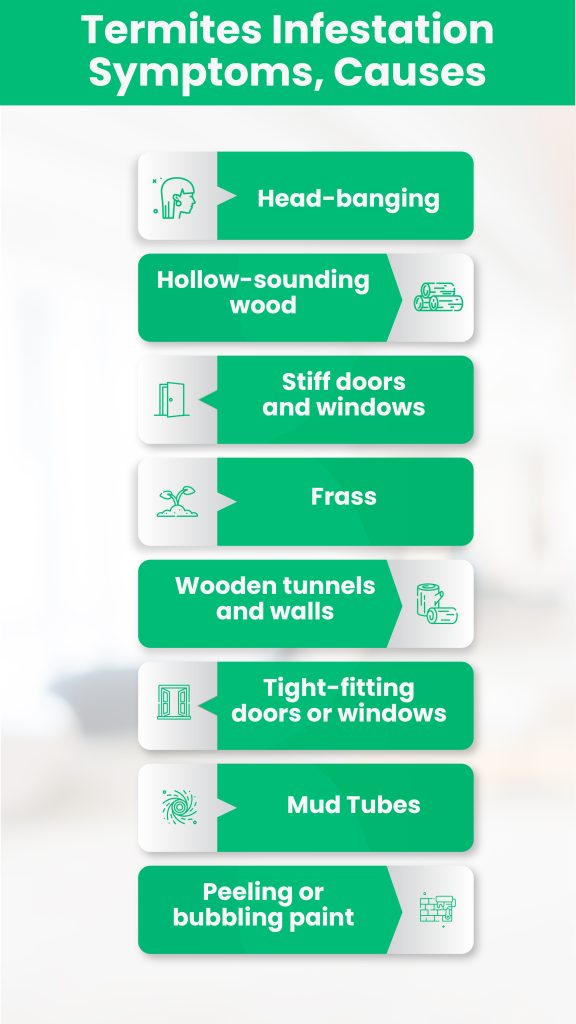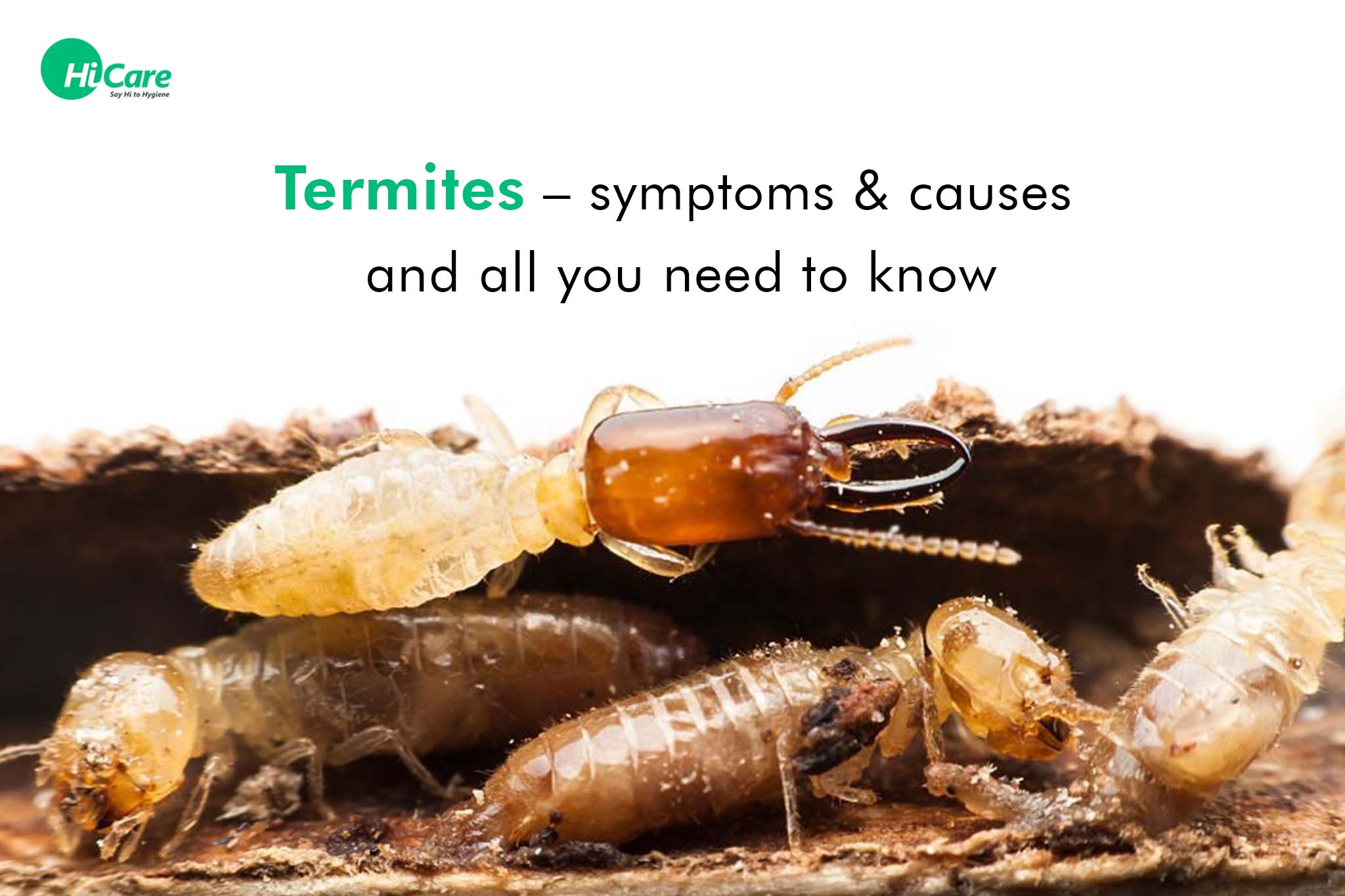For those unfamiliar with termites, they are whitish, soft-bodied insects that like damp cellulose environments. They can pose a significant threat to the plants, trees, and wood in our houses as they like feeding on them. Timber is used in most Indian homes, including flats and villas, for doors and windows as well as woodwork for furniture. We frequently compromise on the wood to be used because the grade of wood fluctuates proportionally with the price. As a result, wood products that have not been treated for insects and vermin are being used. Termites attack at this point.

Termites are extremely destructive and may inflict a lot of damage in a short amount of time. It is important to schedule pest control services as soon as feasible. However, you may only do this if you are aware of a termite infestation. So, let’s look for indicators of termite infestation.
Top 10 Signs of Termite Infestation
- Head-banging: No, this isn’t to rock or heavy metal, contrary to popular opinion. You could hear a weird sound if you put your ears close to the walls or wooden furniture. When worker termites hammer their heads on the wood to warn the colony that they are in danger, this is known as headbanging.
- Hollow-sounding wood: Termites consume wood from the inside out, so look for papery or hollow wood. This implies it will be hollow from the inside out, with only a coat of paint or a thin covering of wood on the outside. If you hear hollow or papery sounds when you knock on these spots, you have termites!
- Stiff doors and windows: Termites develop dampness while tunneling through door and window frames, making it difficult to access doors and windows. This causes the wood to distort, making doors and windows stiff and difficult to open and close.
- Frass: Termites leave behind frass, which may be found all over the area, indicating that you have visitors. Dry wood termites leave their droppings at the start of their tunnels, creating a black powdery residue surrounding the region they are infesting, whereas subterranean termites utilize their feces to create tunnels.
- Wooden tunnels and walls: Termites use tunnels, also known as galleries, to travel around inside the contaminated region. These tunnels are sometimes difficult to identify with the naked eye, but they may be found if you look intently in cracks in the timber. That’s when you realize you’ve got a problem!
- Tight-fitting doors or windows: In modern homes, the majority of doors, windows, and frames are still constructed with wood. Termites may reach them from underneath the floor or from outside your home, so they are usually the first locations they attack. Stuck doors are mainly caused by the natural expansion of the wood. Termites, on the other hand, are occasionally to blame.
- Mud Tubes: To get from their nest to the wood they are eating, termites construct tubes out of mud and other materials. You can find these tubes on surfaces like walls, ceilings, and other places,
- Peeling or bubbling paint: As termites feed on wood, they can cause damage to painted surfaces as well. If you notice paint that is peeling or bubbling for no apparent reason, it could be a sign of termite damage.
- Musty odors: As termites eat wood and tunnel through it, they release moisture, which can provide a musty odour in the area.
- Soft or spongy wood: If you press on a wooden surface and it feels soft or spongy, it could be a sign of termite damage.
Whether you have hired specialists to treat your home for termites or for bed bugs control, it is critical to clear your home. Pay careful attention to discarded papers, cardboards, old magazines, and newspapers, since they give ideal conditions for termites to develop. If termites have infested one of your rooms, never move the contents of that room, including furniture, to other sections of your house where the termites are not present.
5 Common Causes of Termite Infestation
- Moisture: This is by far the most common cause of termite colony formation in your home. Leaky faucets, damaged roof tiles, garden mulch, doors and windows, cardboard and other cellulose materials, and all wood and timber furniture at home fall into this category. The greatest termite prevention method is to keep your home dry.
- Wooden pathways leading to your house: If you have any wood or cellulose objects close to your home, move them further away. These serve as links between termites outside and within your house.
- Geographical location: Due to the environment of the region, homeowners in warmer and wetter states or regions are more prone to termites breeding at home.
- Cracks in walls and other exteriors: As previously indicated, damaged roof tiles can allow water to leak in, providing a perfect environment for termites. Termites can also enter your home through fractures and gaps in the walls. The simplest approach to avoid this is to caulk and cover any holes, which will kill any current termites in the crevices while also preventing new colonies of termites from entering.
Termites are harder to eliminate than most other household pests. They do not respond to insecticides. Traditional and outdated termite treatment methods employ hazardous chemicals that are harmful to our health and can stain or even destroy our walls and furnishings. Termites consume food 24 hours a day, seven days a week. This means they are continually eating and destroying wood. Termites can weaken the timber in your home, resulting in more expensive damages if left untreated. Although you can try DIY techniques to get rid of termites at home, it’s always preferable to get expert help. Also, calling in a reliable carpenter or handyman will not produce satisfactory outcomes. Fortunately, you can count on HiCare to execute an excellent job.
About HiCare
Our pest treatment technicians use highly safe chemicals and spray with considerable caution so that no neighboring furniture or walls are harmed. As a result, you save money because you don’t have to repaint or repair anything. Furthermore, you do not need to seek additional assistance after only a few days. Although you can try DIY techniques to get rid of termites at home, it’s always preferable to get expert help. Our termite control service follows a ‘Drill-FIll-Seal’ technique to kill termites at home. Without a doubt, try HiCare! For more information or to book your appointment, take a look at their website at HiCare.
Frequently Asked Questions about Termites
1. What types of termites are there?
Subterranean, drywood, and dampwood termite species are among the many different types of termites. Each variety of termite has unique traits, preferences for habitat, and food sources..
2. How do you prevent a termite infestation?
As damp or decaying wood is more vulnerable to termite attack, it is crucial to keep wooden structures and other materials dry and well-maintained in order to prevent a termite infestation. Termites can also be deterred by regular inspection, pesticide treatments, and other preventative measures.
3. How do you get rid of a termite infestation?
Termite infestation treatment can be difficult and may call for expert pest control services. Depending on the extent and location of the infestation, treatment options may include fumigation, insecticide applications, or baiting systems.
4. Can termites harm humans?
Termites rarely cause direct harm to people, but they can seriously harm buildings and other property, which can be expensive to fix or replace. Rarely, continuous exposure to termite dust or chemicals used to treat termite infestations may cause respiratory problems or other health complications.
5. Where are termites found?
Termites are a worldwide problem that can infest both urban and rural households and other structures. Although they may thrive in colder climates, they are most frequently seen in hot and humid locations.
6. How long do termites live?
Termite average lifespan varies with species and environmental factors, however the majority of species last for many years to several decades. Queen termites, who are responsible for producing new colony members, can live for many years.





